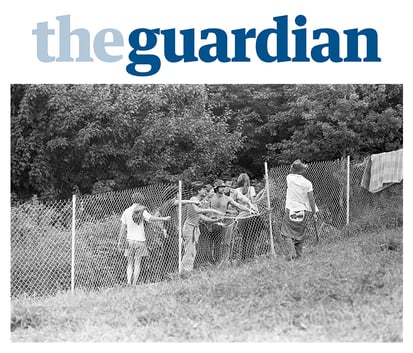The Guardian
Baron Wolman's Woodstock photographs: 'I thought, There'll never be anything like this again'
Photographer Baron Wolman was assigned to take pictures of the bands at Woodstock. But his shots of the crowd were far more revelatory.
"If you focus on the soup," says Baron Wolman, 76, "you miss the salad."
This was the Californian photographer's guiding principle when, as a young man working for Rolling Stone, he arrived at Woodstock in August 1969. Wolman had spent the summer touring US music festivals, photographing musicians on stage. "I was getting tired of it," he recalls.
So looking around at Woodstock – the crowds, the cows, the mud, the drugs – Wolman decided to switch focus and shoot the spectators. He'd attended festivals that summer with 10,000 or 20,000 people; more than 400,000 descended on the farm in Bethel, New York for Woodstock, where Jimi Hendrix, Joan Baez, the Who, the Grateful Dead and others were booked to perform.
"It was the first gathering of that many people for a concert," says Wolman. "I thought: 'There will be more music. But there will never be anything like this again.'" His photographs, some of them never published, collected in a new book and excerpted here, offer a fresh perspective on an event that has entered legend.
Woodstock might have been a catastrophe, says Wolman. The men who planned it, led by a charismatic 20-something promoter called Michael Lang, had anticipated 200,000 attendees – tops. "There wasn't enough food," says Wolman. "The sanitary facilities were limited. People were trapped in the centre of these huge crowds, couldn't move around. There were some bad drugs."
He photographed it all, the piles of rubbish, the people sleeping on hay bales, the shaman-like figure who wandered around for three days advising people not to eat meat. Wolman sought to capture some of the spirit of make-do and goodwill that allowed Woodstock to work.
"People had no idea what they were buying a ticket for. Now you know – you go to Glastonbury, and everything is planned, no question. The barriers, the tickets, everything that's typical of big modern festivals. At Woodstock, nobody knew how to plan a festival of this size, so things evolved organically. I saw it happening and it was magic… There was a spirit in the air, man. There was a spirit that was communicated, without stating it, that this thing was to be peaceful."
Among his shots of a peaceful if increasingly grimy crowd, Wolman captured a group of daredevil spectators climbing up speaker scaffolding. There were great worries about this scaffolding, when a sudden storm hit Bethel on day three. "It was scary," says organiser Lang, quoted in Wolman's book, "having all the heavy lighting equipment on these towers over everyone's heads." Wolman's chief memory of the sudden rain was that "everything got funky". At one point he followed a group of hippies down to a river, where they bathed together in the nude.
"You see nothing really was forbidden. I think that everybody made a compact with themselves and their neighbours saying that anything was acceptable, except violence and being violent to one another. Even stuff that was fundamentally illegal at the time was permissible."
People bought and took drugs, freely, in front of his lens. "Any behaviour was permissible as long as it didn't negatively affect the people at the festival. I don't know how that got communicated but that was absolutely the character of the crowd."
In subsequent years there were attempts to replicate the Woodstock of August '69, Wolman says. "Michael Lang and his people put on two more… They were fine festivals. But you can't match something that was unplanned, spontaneous."
"I knew, man," he says. "I knew at the time this was going to be a significant moment in the story of music on this planet."






